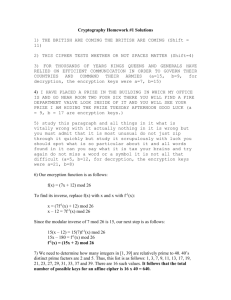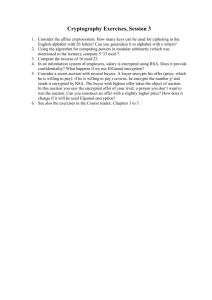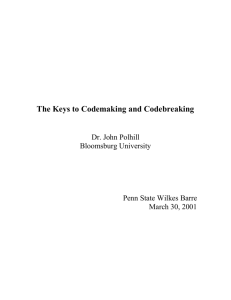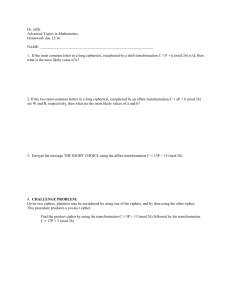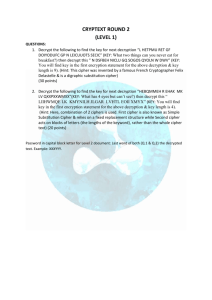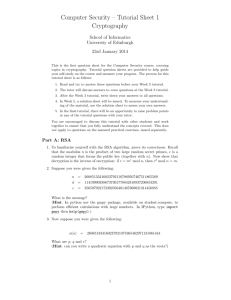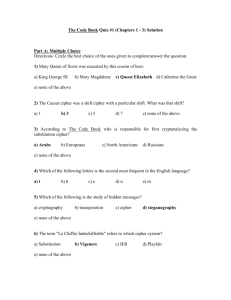Lecture 2
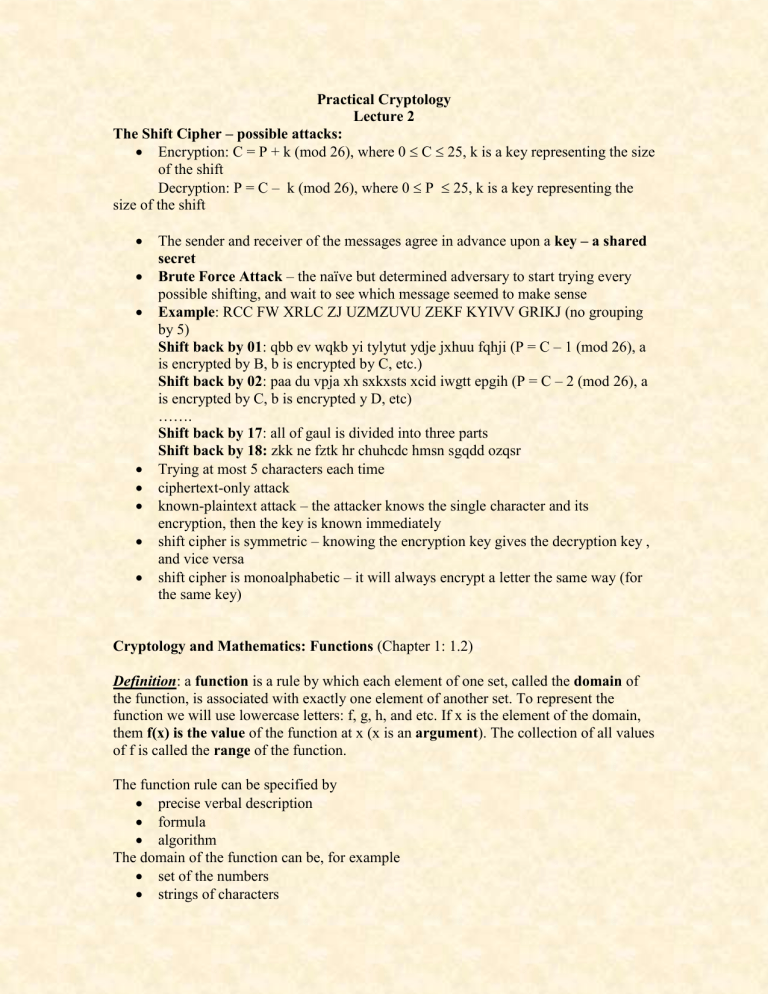
Practical Cryptology
Lecture 2
The Shift Cipher – possible attacks:
Encryption: C = P + k (mod 26), where 0
C
25, k is a key representing the size of the shift
Decryption: P = C – k (mod 26), where 0
P
25, k is a key representing the size of the shift
The sender and receiver of the messages agree in advance upon a key – a shared secret
Brute Force Attack – the naïve but determined adversary to start trying every possible shifting, and wait to see which message seemed to make sense
Example : RCC FW XRLC ZJ UZMZUVU ZEKF KYIVV GRIKJ (no grouping by 5)
Shift back by 01 : qbb ev wqkb yi tylytut ydje jxhuu fqhji (P = C – 1 (mod 26), a is encrypted by B, b is encrypted by C, etc.)
Shift back by 02 : paa du vpja xh sxkxsts xcid iwgtt epgih (P = C – 2 (mod 26), a is encrypted by C, b is encrypted y D, etc)
…….
Shift back by 17 : all of gaul is divided into three parts
Shift back by 18: zkk ne fztk hr chuhcdc hmsn sgqdd ozqsr
Trying at most 5 characters each time
ciphertext-only attack
known-plaintext attack – the attacker knows the single character and its encryption, then the key is known immediately
shift cipher is symmetric – knowing the encryption key gives the decryption key , and vice versa
shift cipher is monoalphabetic – it will always encrypt a letter the same way (for the same key)
Cryptology and Mathematics: Functions (Chapter 1: 1.2)
Definition : a function is a rule by which each element of one set, called the domain of the function, is associated with exactly one element of another set. To represent the function we will use lowercase letters: f, g, h, and etc. If x is the element of the domain, them f(x) is the value of the function at x (x is an argument ). The collection of all values of f is called the range of the function.
The function rule can be specified by
precise verbal description
formula
algorithm
The domain of the function can be, for example
set of the numbers
strings of characters
collections of functions
etc
Examples:
g(x) is the function the encrypts string x using shift cipher with k = 5. g(form) =
KTWR
function of more than one variable: m(x,k) encrypts string x using shift cipher with key k m(weconcur, 4) = AIGSRGYV, m(weconcur, 7) = DLJVUJBY
instead of the second variable, use subscript: shift with key k = 2: m
2
(letstalk) =
NGVUVCNM
Definition: a function is called one - to – one if each element of the range is associated with precisely one element of the domain.
Example: t(x) is the truncation of string x to it’s four first letters. t(thunder) = THUN and also t(thunderstorm) = THUN
Definition: Each function f that is one- to – one has an inverse function ,
f
-1
that is computed by this rule: if y is an element of the range of f then
f
-1
(y) is the element of the domain such that f(x) = y.
Definition: The composition of two functions f and g where the range of f is contained in the domain of g is defined by:
( g
f ) ( x ) = g( f ( x ) )
Rules for function f and inverse
f
-1 f(f
-1
(y)) = y, for all y in the range of f f
-1
(f(x)) = x, for all x in the domain of f
Connection between cryptology and functions
an encryption method defines one – to – one function for each key
the corresponding decryption method is the inverse of this function
encrypting – evaluation of the function for a given key
decrypting – evaluation of the inverse of the encryption function for a given key
Permutations: a permutation of n ordered objects is a way to reordering them. One-to– one function.
------------------------------------------------
Modular Arithmetic:
Let m be a positive integer (the modulus of our arithmetic). We say that two integers a and b are congruent modulo m if b-a is evenly divisible by m and we write a ≡ b (mod m).
Examples:
3 ≡ 3 (mod 10), - 6 ≡ 4 (mod 10)
